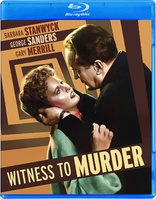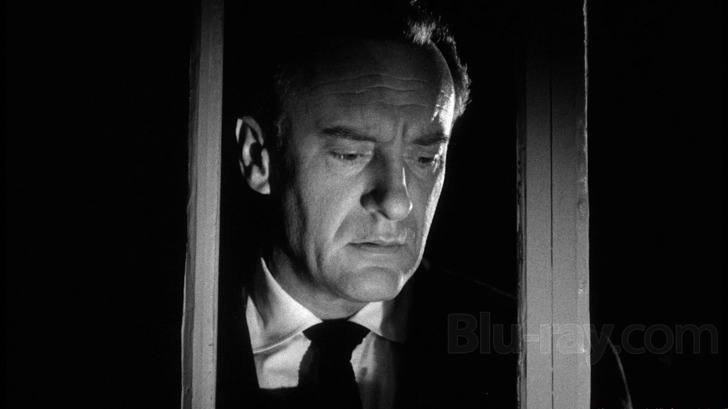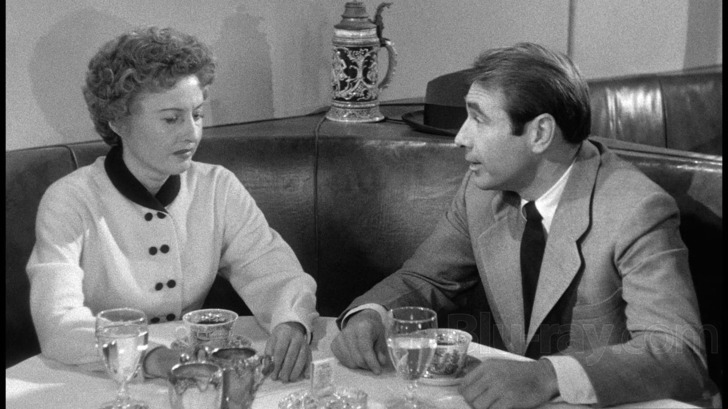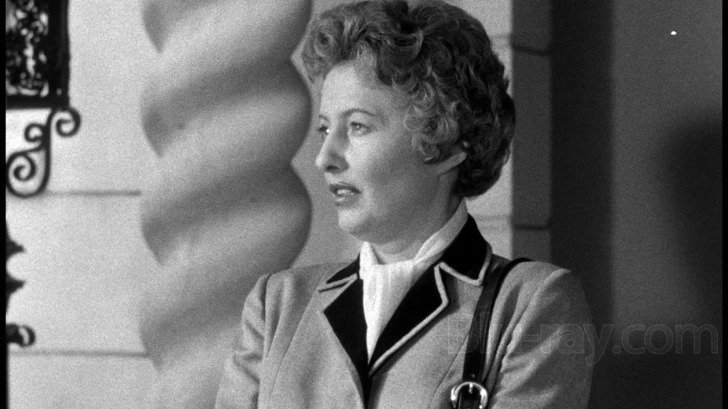Witness to Murder Blu-ray Movie
HomeWitness to Murder Blu-ray Movie 
Kino Lorber | 1954 | 82 min | Not rated | Dec 02, 2014
Movie rating
6.6 | / 10 |
Blu-ray rating
| Users | 0.0 | |
| Reviewer | 2.5 | |
| Overall | 2.5 |
Overview
Witness to Murder (1954)
A woman's sanity comes into question after she claims to have witnessed a murder from her apartment window.
Starring: Barbara Stanwyck, George Sanders (I), Gary Merrill, Jesse White, Harry Shannon (I)Director: Roy Rowland
| Film-Noir | Uncertain |
| Drama | Uncertain |
| Crime | Uncertain |
Specifications
Video
Video codec: MPEG-4 AVC
Video resolution: 1080p
Aspect ratio: 1.75:1
Original aspect ratio: 1.75:1
Audio
English: DTS-HD Master Audio 2.0 Mono (48kHz, 16-bit)
Subtitles
None
Discs
25GB Blu-ray Disc
Single disc (1 BD)
Playback
Region A (B, C untested)
Review
Rating summary
| Movie | 2.5 | |
| Video | 3.0 | |
| Audio | 3.5 | |
| Extras | 0.5 | |
| Overall | 2.5 |
Witness to Murder Blu-ray Movie Review
Front window.
Reviewed by Jeffrey Kauffman December 18, 2014Quick—name a 1954 movie where a nosy neighbor spies out of their apartment window and believes they’ve witnessed a murder, only to find out no one believes them. Rear Window, right? Well—yes and no. Alfred Hitchcock’s claustrophobic masterpiece is one of the master’s most beloved fifties’ outings, offering a nice (albeit debilitated) turn by James Stewart as injured photographer Jeff Jefferies, who, holed up in his flat with a broken leg, begins noticing all the sometimes bizarre vignettes playing out in neighboring apartments that he can spy into across a courtyard. But about four months or so before Rear Window hit cineplexes a by now largely forgotten film opened with much the same setup, if admittedly a far different execution and success quotient. Witness to Murder posits Barbara Stanwyck as Cheryl Draper, a woman who arises on a stormy, windy night to shut her front window, coincidentally at the same time an across the street neighbor seems to be murdering a woman, all right there in full view inside of his window. Cheryl, panicked of course, immediately calls the police, but those darn cops show up with lights blazing and sirens blaring, leading the murderer to peer outside of his window, figure out that he might be in trouble, leading him to quickly find a hiding place for the corpse in his home. When the cops come to question the man, who turns out to be a natty, somewhat unctuous guy named Albert Richter (George Sanders, in typically smug mode), there’s no evidence of any struggle, aside from a torn curtain (hey—maybe Hitchcock saw this film!), which Richter goes to some lengths to disguise. That sets up the rest of the film, where an increasingly desperate Cheryl tries to get the goods on Richter, while Richter, no wilting wallflower a la Raymond Burr in Rear Window, goes to work trying to make sure everyone thinks Cheryl is an apt candidate for the looney bin.

It’s probably unfair to compare Witness to Murder with Rear Window, if for no other reason than journeyman director Roy Rowland (Hit the Deck and Boomer cult item The 5000 Fingers of Doctor T) is certainly not Alfred Hitchcock. But it’s at least instructive to note one salient difference between the two films, other than obvious gender swap in the lead character department, and the fact that Witness to Murder ends up playing more like a melodrama than a traditional mystery (since, after all, the murder is depicted quite openly in the film’s opening sequence). Hitchcock frames (literally and figuratively) virtually the entire film of Rear Window within the confines of Jeff’s small apartment, making Jeff both voyeur and in a very real way a trapped rat. Rowland on the other hand has Cheryl traipsing all over the place in her relentless pursuit to prove Richter is a cold blooded killer, something that ultimately gets her involved with policeman Lawrence Mathews (Gary Merrill) and, ultimately (in the film’s most ludicrous segment), a one way ticket to the local nuthouse, where she’s evidently put through a regimen of drug therapy to help her overcome her “obsession.”
The fact that Richter turns out to have a nefarious past at least alerts Mathews to the possibility that Cheryl is not completely out of her mind, but the film then detours into its ludicrous subplot of Richter setting Cheryl up as a neurotic nutcase who is supposedly stalking him. By the time Cheryl has been admitted to the local lunatic asylum (against her will, of course), Witness to Murder has jettisoned any ragged semblance of verisimilitude, tipping over fairly unapologetically into florid, overheated melodrama. By the time Cheryl gets out of the sanitarium, things are so divorced from “reality” that the film’s climax almost plays like a Harold Lloyd comedy, with combatants going at each other on a precarious high rise, while traffic flows by several stories below and an aggregation of curious onlookers gazes skyward to try to figure out what in heaven’s name is going on up there.
Witness to Murder has a typically tough but vulnerable performance from Stanwyck, who admittedly doesn’t have a lot to work with as a somewhat generic damsel in distress. That very toughness tends to also undercut the film’s thesis that Cheryl is being railroaded by a dangerous madman. There are also curious (if understandable, given the film’s vintage) touches, like the fact that Cheryl is absolutely perfectly made up, including wearing a liberal dose of lipstick, as she’s “sleeping” in the film’s opening sequence. Interestingly, the film tends to shy away for the most part from an overt romantic angle vis a vis Cheryl and Detective Mathews, though of course there’s a pretty solid clinch between the two at the film’s close.
They say that timing is everything (or at least most things) in show business, but the fact that Witness to Murder predated Rear Window by several months but never really took off and is certainly nowhere near as well remembered as the Hitchcock outing seems to prove that inherent quality may be part of the equation as well. There’s nothing really horrible in Witness to Murder, but it tends to trundle along as a midlevel potboiler, while Rear Window accelerates to a devastatingly effective climax out of many of the same building blocks.
Witness to Murder Blu-ray Movie, Video Quality 

Witness to Murder is presented on Blu-ray courtesy of Kino Lorber Studio Classics with an AVC encoded 1080p transfer in 1.75:1. This is a fairly modest looking high definition upgrade, though there are moments when depth, contrast and clarity outshine the bulk of the presentation. Things are frequently soft and rather heavily grainy, perhaps indicating this was sourced at least partially from dupe elements. There are, however, some striking exceptions (see screenshot 16 for a good example). The majority of this transfer features underwhelming black levels and anemic contrast. That's especially unfortunate in that the film was lensed by the wonderful John Alton (An American in Paris), who lights a number of scenes very evocatively in a quasi- noir fashion. There are no signs of digital manipulation, however, so neither artificial sharpening nor noise reduction play into the appearance of the film.
Witness to Murder Blu-ray Movie, Audio Quality 

Witness to Murder's lossless DTS-HD Master Audio 2.0 mono mix provides suitable support for a fairly talky enterprise, with somewhat less full bodied support for Herschel Burke Gilbert's punchy brass inflected score. Dialogue is presented cleanly and is well prioritized. There's no real damage per se, though the track's age is apparent in a somewhat boxy way.
Witness to Murder Blu-ray Movie, Special Features and Extras 

- Trailer (480i; 2:08)
Witness to Murder Blu-ray Movie, Overall Score and Recommendation 

Witness to Murder is a middling effort that unfortunately can't quite get out from under the looming shadow of Rear Window, a film that tops it in directorial acumen and development of the premise. There are still some interesting elements here, including the fact that the entire setup takes place behind the opening credits sequence, and a couple of well done suspense scenes, including the segment where Richter hides the corpse. But if you see only one film about a nosy neighbor spying through a window and witnessing a murder, make it Rear Window.
Similar titles
Similar titles you might also like

A Bullet for Joey
1955

Big House, U.S.A.
1955

He Ran All the Way
1951

Storm Fear
1955

Where the Sidewalk Ends
Limited Edition to 3000 - SOLD OUT
1950

Private Hell 36
1954

The Killer Is Loose
Special Edition
1956

Mystery Street
Warner Archive Collection
1950

Crime of Passion
1957

Black Widow
Limited Edition to 3000
1987

Motherless Brooklyn
2019

On Dangerous Ground
Warner Archive Collection
1951

Boomerang
1947

Five Steps to Danger
5 Steps to Danger
1957

Shield for Murder
1954

Impact
Collector's Edition
1949

Dragnet
1954

The Big Combo
1955

Phantom Lady
1944

Crossfire
Warner Archive Collection
1947